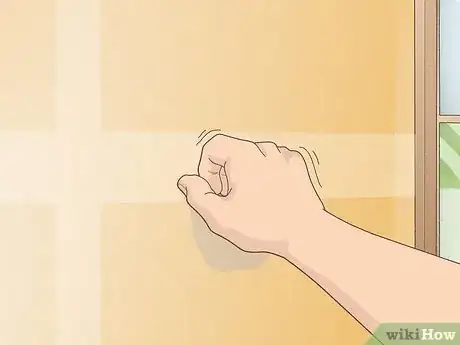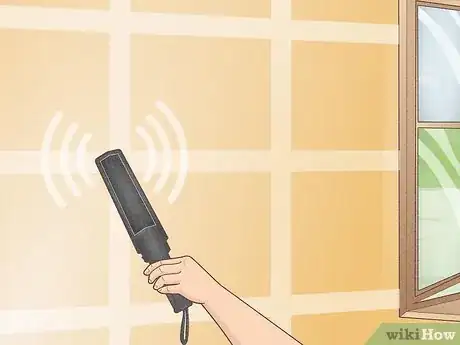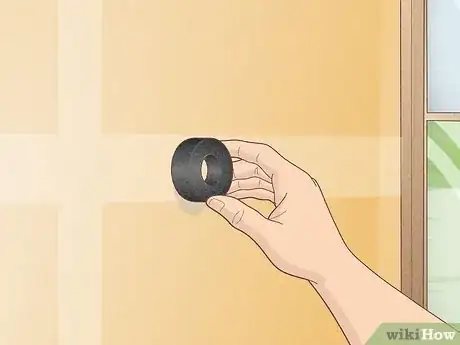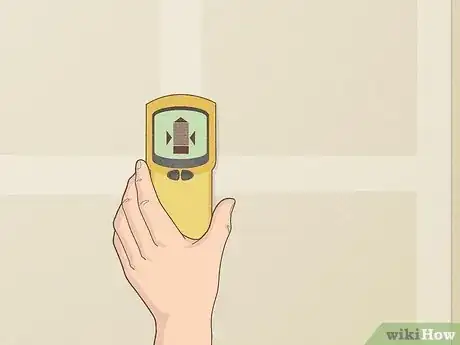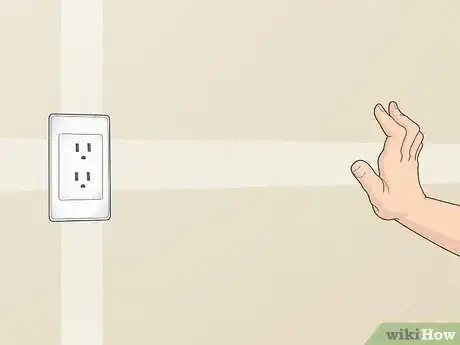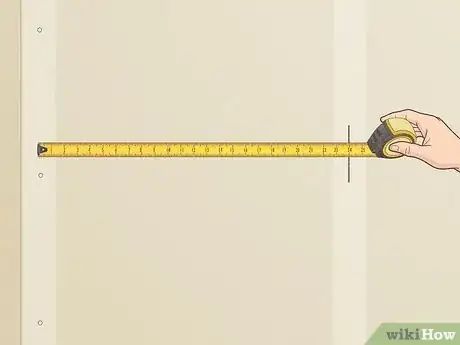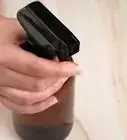This article was co-authored by Josh Goldenberg and by wikiHow staff writer, Hunter Rising. Josh Goldenberg is a Residential Remodeling Expert and the Co-Founder of 5blox, based in the Greater Los Angeles area. With more than seven years of experience, Josh and his team specialize in luxurious and sustainable home renovations. 5blox is fully licensed and bonded.
This article has been viewed 27,573 times.
Are you trying to hang something up on a plaster wall, but want to make sure it stays put? While you can attach lighter objects to the wooden slats, heavy TVs or decor need a sturdy stud for a base. Even though plaster walls are a little too thick for standard stud finders to work, there are still other easy ways to locate a stud in your wall. Keep reading for everything you need to know about finding a stud so you can hang your items securely!
Steps
Listen for a deep thud when you knock on your wall.
-
According to Residential Remodeling Expert Josh Goldenberg, "a knock on top of a studded location will have a much deeper sound." Lightly tap along your wall with your knuckles and listen to the sound. If you hear an echoey hollow sound, it means there’s nothing behind the wall where you’re tapping. Move across your wall and keep tapping until you hear a solid thunk, which means there’s a stud behind the plaster.[1] X Research source
- Listen very carefully when you do a knock test since the horizontal wooden slats behind the plaster could make a similar noise.
Look for where baseboards are nailed to your wall.
-
Residental Remodeling Expert Josh Goldenberg explains, "Oftentimes, baseboards are nailed to the wall on the studs. Similarly, switches and outlets are mounted on studs as well." Check the baseboards along the floor to see if you can find nail heads or divots in the wood. Keep your eyes peeled since the nail holes are usually painted over or filled in when they’re finished. If you find a spot where the baseboard is nailed in, knock on the wall to see if it makes a solid thunk to make sure there’s a stud there.[2] X Research source
- If the wall sounds hollow when you tap on it, then try to find another nail in the baseboards.
Run a metal detector over your wall.
-
Metal detectors find where slats are nailed into studs. Use a small handheld metal detector and place the edge flush against your wall. Slowly run the detector across your wall in long sweeping motions. When you hear the metal detector beep, run it over the wall even slower to zero in on the position of the nails. Mark the stud’s location with a pencil so you don’t forget it.[3] X Research source
- You may get inaccurate readings if your plaster wall has a wire mesh support.
Hold a strong magnet against your wall.
-
The magnet will stick to the hardware already in your studs. Use a heavy-duty magnet rather than a small flimsy one on your fridge. Tie a piece of string around the magnet and hold it against your wall. Walk slowly along the wall, dragging the magnet across the surface to see if it sticks. If it ever gets stuck, it could mean that there’s a stud behind the plaster.[4] X Research source
- The magnet picks up where the horizontal wooden slats are nailed into the studs.
- If you have metal slats or supports behind your plaster, then a magnet won’t give you conclusive results and you’ll need to try another test.
Use a magnetic stud finder.
-
Magnetic stud finders stick to where your studs are nailed to the wall frame. According to Residential Remodeling Expert Josh Goldenberg, "stud finders work magnetically [...] to locate your studs without much guesswork." A magnetic stud finder is a small cube- or bar-shaped tool that’s attracted to nails and screws. Hold the magnetic stud finder against the wall about 1–2 inches (2.5–5.1 cm) from the floor or ceiling. Slowly walk the magnet across your wall until you meet resistance, which means you’ve hit a stud.[5] X Research source
- Magnetic stud finders won’t work if you have metal supports instead of wood behind the plaster.
- Stud finders are rather inexpensive devices that are easy to use.
Find a stud attached to an outlet or switch.
-
Electrical boxes are attached to studs that you can use as references. Residential Remodeling Expert Josh Goldenberg shares that "similar [to baseboards], switches and outlets are mounted on studs." If you have a wall outlet, switch, or any other type of electrical box on the wall, there’s a stud running along either the left or right side.[6] X Research source Take the faceplate off of the outlet or switch and position a screwdriver in the bottom corner between the electrical box and the plaster. Push the screwdriver in gently, and if it meets resistance, then the stud is on that side of the box.[7] X Research source
Measure 16–24 in (41–61 cm) from known studs.
-
Studs are the same distance apart throughout your entire wall. If you know the location of one stud but you want to find another in your wall, you can easily measure them. Since the centers of studs are usually 16–24 inches (41–61 cm) apart, just stretch a tape measure across your wall starting on the known stud. Mark your measurement on the wall so you know where the other studs are located.[8] X Research source
- Studs run vertically up the wall, so any that you find will span from the floor to the ceiling.
Drill into the wall where you think there’s a stud.
-
You’ll feel resistance the entire time if you hit a stud. Use the smallest drill bit made for wood that came with an electric drill. If you think you found a stud in your wall, position the drill right above your baseboards and slowly drill a hole into the wall. If the drill bit has some resistance before easily slipping through the wall, then you missed the stud.[9] X Trustworthy Source Consumer Reports Nonprofit organization dedicated to consumer advocacy and product testing Go to source
- You can easily patch the hole in your wall if you missed the stud.
- Avoid using a hammer and nail on plaster walls since you could easily crack or chip the finish.
You Might Also Like

 How to Get Spray Foam off Your Hands
How to Get Spray Foam off Your Hands






 How to Defrost a Samsung Ice Maker: A Quick Guide
How to Defrost a Samsung Ice Maker: A Quick Guide



References
- ↑ https://www.nytimes.com/1991/02/03/nyregion/home-clinic-locating-hard-to-find-wall-studs.html
- ↑ https://youtu.be/5q6dPqGZn1Y?t=66
- ↑ https://upgradedhome.com/how-to-find-studs-in-plaster-walls/
- ↑ https://upgradedhome.com/how-to-find-studs-in-plaster-walls/
- ↑ https://www.nytimes.com/1991/02/03/nyregion/home-clinic-locating-hard-to-find-wall-studs.html
- ↑ https://www.latimes.com/archives/la-xpm-1990-04-15-re-1879-story.html
- ↑ https://youtu.be/5q6dPqGZn1Y?t=110
- ↑ https://www.latimes.com/archives/la-xpm-1990-04-15-re-1879-story.html
- ↑ https://www.consumerreports.org/furniture/how-to-anchor-furniture-to-help-prevent-tip-overs-a4328328212/
About This Article

